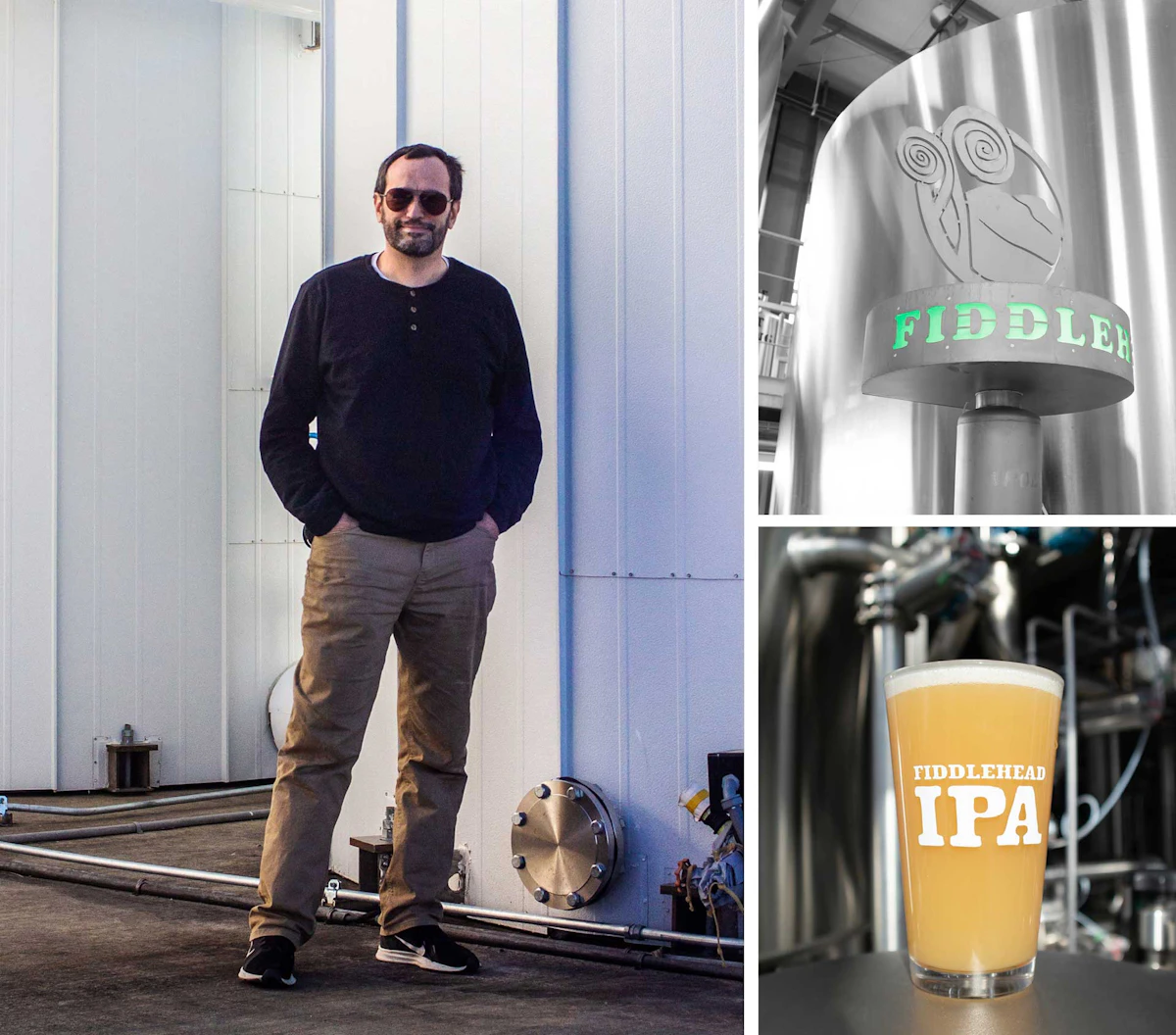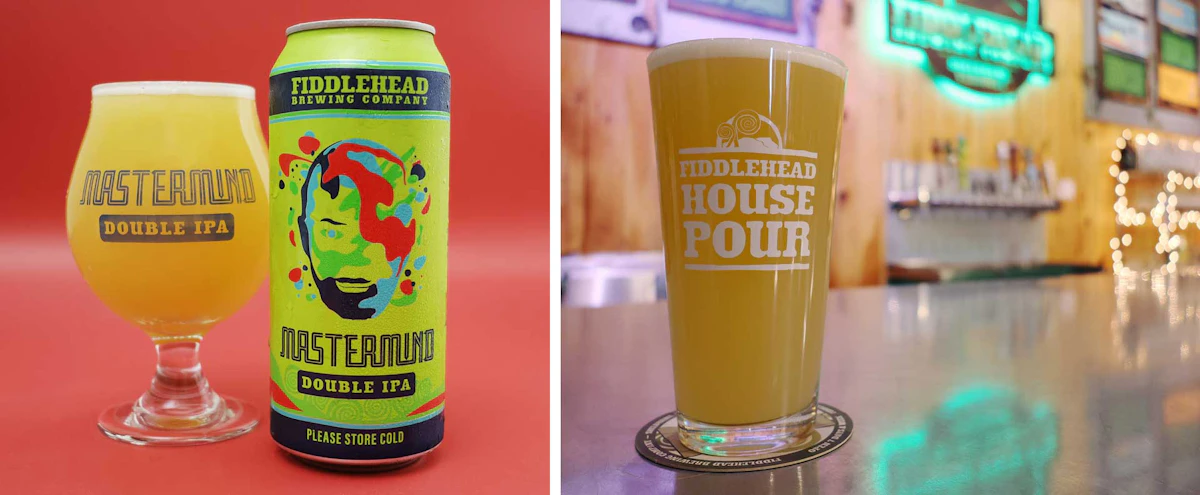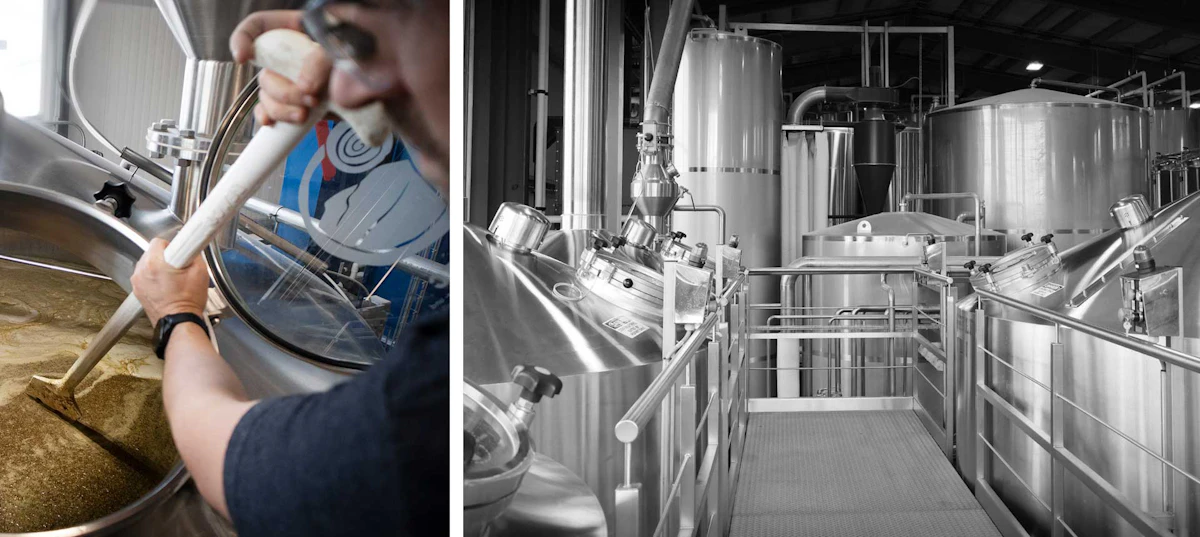Discipline is defined as much by the choices you make as the ones you don’t. In the course of nearly 15 years, Fiddlehead Brewing in Shelburne, Vermont, has said no many times—but when the brewery says yes, it commits emphatically.
That ruthless focus has led to continued year-over-year growth for the regional brewery, which expects to grow production another 12–15 percent this year despite not entering new states. Even in two of its most established markets, Vermont and Massachusetts, Fiddlehead’s wholesale orders grew by double digits last year. Ranked 23rd on the Brewers Association’s top 50 largest craft breweries by volume in 2024, Fiddlehead may well crack the teens this year while its cohorts struggle to maintain production volumes.
While regional breweries on the whole were down 3 percent last year, Fiddlehead grew 20 percent to more 108,000 barrels. That level of production amid a grueling sales landscape is eyebrow-raising. Even more incredible is that about 85 percent of the brewery’s total barrelage came from a single beer: Fiddlehead IPA.
Those numbers may surprise outsiders, but not Fiddlehead owner Matt Cohen. To hear him tell it, this is all in line with his grand plan.
“When I set out to start Fiddlehead, I envisioned having a regional if not national brand that focused solely on one well-balanced, accessible IPA,” Cohen says. “So, from Day One, the mission hasn’t changed. The sales have just kept coming.”
That level of confidence—hubris, even—could be off-putting in an industry that tends to enjoy a scrappy underdog image. Yet Cohen has four decades of industry experience and years of brewery growth behind his claims. He admits that he’s not especially chummy with many other brewers or owners, but those who’ve known him the longest say they respect what he’s built with Fiddlehead.
That’s the case for Todd Haire, who met Cohen as a fellow brewer at now-shuttered Magic Hat Brewing in Burlington, Vermont. Haire later cofounded Foam Brewers in the same town.
“Fiddlehead was a very basic startup, but Matt had a great focus on one beer—a draft beer that didn’t exist at the time in Vermont,” Haire says. That nonexistent beer was a hazy IPA that major wholesalers would deliver to retail shelves. “I have loved seeing his brewery grow and be as successful as it has.”
Haire describes Cohen as not just relentlessly focused but hungry. “He’s always been competitive—in my opinion, in a good way—from being the Magic Hat softball coach to money games in disc golf or being driven to sell the most beer in the state.”
Indeed, Cohen likes to be the ultimate decision-maker at the brewery, which owns its building and has no outside investors. It’s a choice that Cohen makes to avoid “losing control,” and it means he’ll be as responsible for Fiddlehead’s future as he has been for its impressive rise. He has expectations for Fiddlehead’s continued success, going deeper into its existing 10-state distribution footprint while moving volume through large venues such as Fenway and Citizens Bank parks.
And while he says he’ll remain steadfast in the brewery’s core mission—to produce an accessible, high-quality, competitively priced regional IPA—he’s proven that commitment doesn’t have to mean rigidity.

All in on IPA
If the COVID-19 pandemic hadn’t happened, Fiddlehead IPA might still be draft-only. A difficult decision faced Cohen in 2020, when draft sales dried up overnight and Fiddlehead bought back $1 million in kegged beer from its wholesalers.
Believing that beer is best served on draft, and knowing that distributors tend to always refrigerate kegs, Cohen had never planned to can or bottle Fiddlehead’s flagship IPA—in fact, he says, he’d hoped not to. But the pandemic left him with little choice—who knew how long the on-premise would be shut down?
However, the brewery already had been canning its double IPAs, Second Fiddle and Mastermind, so it had some packaging experience. What it didn’t have was retail placements. That’s where Fiddlehead cashed in on the goodwill it had built with wholesalers.
“We were able to get into, or we were forced into, most of these [retail] sets,” Cohen says. “And dollar-wise, we grew our business 25 percent that year.” Today, the brewery’s packaging mix is 55 percent cans, 45 percent draft.
Cohen says Fiddlehead is proud to be able to lean on its distributor partners, who represent “the most important relationship we will have as a company.”
It’s easy to see why wholesalers appreciate the brewery. Among dozens of other craft breweries with complicated portfolios and rotating cycles of boom-and-bust beyond-beer products, Fiddlehead comes to annual business-plan meetings every year with one priority: sell Fiddlehead IPA. (“Our spring seasonal? Fiddlehead IPA,” Cohen quips. “Summer seasonal? Fiddlehead IPA. Fall seasonal? You guessed it.”)
While some bars are reducing draft lines or cutting space for craft, they put a premium on proven winners with consistent product and strong velocity. Last year, analysis by Bump Williams Consulting for the Brewers Association showed that among the 150 largest craft breweries, those with strong-focus brands outperformed the broader set. Breweries with relatively fewer brands that stick to traditional beer—rather than beyond-beer innovations—fared better than the rest. That led Williams to conclude that “greater focus correlates to stronger volume sales trends.”
That was especially true of IPAs, craft’s most popular style. Those large breweries for whom IPA made up two-thirds or more of total case sales grew volumes 1.7 percent between summer 2023 and summer 2024. Those who didn’t have such a flagship IPA–heavy portfolio were down by an average of 5 percent.
That consistency doesn’t mean that Fiddlehead IPA is unchanging. The recipe has been the same for the past decade, Cohen says, but it morphed quite a bit in its first few years because of the improving availability of quality raw ingredients. He says he’d be open to tweaking the recipe in the future if drinkers’ palates shifted or if new, better ingredients came to market.

Driving Volume Through Efficiencies
While putting most of its chips behind its flagship, Cohen is clear that Fiddlehead does brew other styles for its taproom, including a wheat ale, pilsner, and a Mexican-style lager with agave and tortilla chips.
“We still have the ability to innovate,” he says, “but a lot of it doesn’t leave our brewery because, again, we want to maintain focus with our distributors. But it’s not to say that we are just sitting idle.”
There are several operational benefits to Fiddlehead’s virtually single-SKU approach:
- First, there’s the aforementioned ease with which distributors and retailers can grasp the brewery’s mission. (Asked what he’d want business partners to say about the Fiddlehead brand, Cohen responds quickly: “Great beer at a great price.”)
- Second, there are efficiencies that come from brewing a single brand at scale—more on that below.
- And third, a portfolio led by one beer in craft’s most popular style gives salespeople a simple message with which to grow the pie of Fiddlehead accounts and drinkers, without worrying about cannibalization or SKU glut.
It’s impossible to overstate the importance of scale and efficiency in Fiddlehead’s story. Buying ingredients in bulk reduces costs, of course, and larger equipment is only fractionally more expensive than smaller equipment—Fiddlehead’s setup takes advantage of all that. The brewery began on a 15-barrel system with 30-barrel tanks—relatively large for a brand-new brewery—before upgrading to a 30-barrel brewhouse years later.
“A 60-barrel tank is not twice as expensive as a 30-barrel tank—it’s about 20 percent more,” Cohen says. “So, I’d rather buy the 60-barrel and have more capacity. But most brewers don’t have the [single] brand power to fill one of those tanks.”
That streamlined approach and focus on volume have allowed Fiddlehead to price its flagship IPA competitively. The 12-pack, which launched during the height of the pandemic, retails for less than $20—usually $17.99 or $18.99. Because of its lower margins relative to other packages, such as 19.2s or four-packs, Fiddlehead doesn’t lead with 12-packs in new markets. Instead, it slowly builds momentum with draft and other package formats, creating enough volume demand to support the lower-margin 12-packs.
In a new market, it first debuts on draft at 25 to 50 accounts, a mix of chain and independent bars and restaurants. A year later, the brewery introduces four-packs of Fiddlehead IPA to develop a following for the cans. Only in year two or afterward—once the brewery’s dedicated chain-sales representative has a proven track record with those large-format placements—will the brewery launch 12-packs.
Cohen says he can work on those tighter margins and longer timelines because he’s the brewery’s sole owner, and he doesn’t need to answer to investors.
“This is the only thing I’ve ever done,” he says. “It’s the only thing I’ve ever wanted to do. It’s the only thing I will ever do. So, this is my life’s work, and I’m very patient.”

Maintaining Core Commitments
In 2025, it’s a challenge for regional breweries to stay both locally relevant and broadly accessible.
Fiddlehead built its craft credibility in the early and mid-2010s, via those from-the-brewery case sales that drew lines of hundreds. (The sales were cash-only, and Cohen says that Fiddlehead was bringing in so many $20 bills that the local bank would call him directly when they were running low on that denomination.)
From there, the brewery expanded draft sales to a handful of Vermont ski resorts, including Sugarbush and Mad River Glen. Those resorts were full of visitors from nearby states, helping to spread the brewery’s reputation and solidifying its connection to idyllic Vermont experiences.
Today, Fiddlehead distributes to 10 states and is available at gas stations, sports arenas, and grocery chains—always stored in the cold box, per the brewery’s contracts. Standing out among a sea of more local options comes down to quality and consistency, Cohen says. The cold-box mandate is critical to that, as is the brewery’s single-beer focus. Burnt by expensive beers of variable quality, consumers appear to be retrenching behind known and trusted brands—especially when they’re affordable and maintain credibility.
Fiddlehead also connects with local consumers and distributors through its charitable program, Team Mastermind. The brewery donates 25 percent of sales of its Mastermind Double IPA in each market to an area charity selected in partnership with the wholesaler. The program launched close to home, funding a play-and-relaxation space at Vermont Children’s Hospital—it’s called the Mastermind Teen Room. Originally honoring Cohen’s son, Noah, whose medical condition required dozens of hospitalizations when he was a child, Team Mastermind has so far donated more than $1 million.
Cohen is realistic: He says he knows he can’t count on drinkers to care about the brewery’s charitable giving or understand the reasons for its cold-box mandate. Instead, he’s adamant that all that matters to drinkers is that the beer tastes good, is attainably priced, and is readily available wherever they want to drink it.
“When we make decisions as a company, it’s about quality,” he says. “That’s what guides our decisions on a daily basis.
